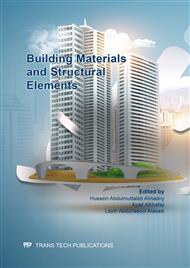p.68
p.77
p.88
p.97
p.110
p.121
p.130
p.139
p.147
Some Mechanical Properties of Polymer Modified Concrete by Adding Waste Iron Filings and Chips
Abstract:
The study aims to improve some mechanical properties like compressive strength, tensile strength, modulus of elasticity and flexural strength of polymer modified concrete (PMC). This improving for PMC done by using waste iron filling as replacement from fine aggregate. waste iron filings and chips used in this research as percentages from sand ranged from 0 % to 40 % , the compressive strength of ordinary polymer concrete increase from 32.2 MPa to 41.81 MPa by 40% replacement of sand with waste iron filings and chips, tensile strength increased also from 2.83 MPa to 4.23 MPa by 40% replacement also. Flexural strength increased from 3.7 MPa for reference mix to about 7.1 MPa for mixes with 40% replacement, modulus of elasticity increased from 21087 MPa to 25233 MPa by using maximum percentage of waste iron filings. There is a slight increment in mechanical properties of polymer modified concrete after 30% ratio of waste iron filings and chips. Also research includes mixes modified with larger dosage of super plasticizer and less water/cement ratio to improve mechanical properties of PMC.
Info:
Periodical:
Pages:
110-120
Citation:
Online since:
August 2021
Price:
Сopyright:
© 2021 Trans Tech Publications Ltd. All Rights Reserved
Share:
Citation:


